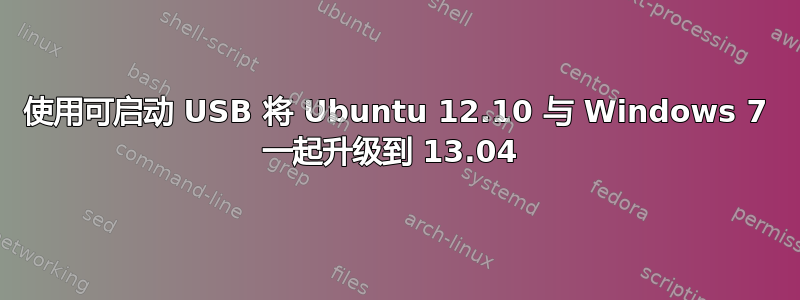
如何使用可启动 USB 将 Ubuntu 12.10 升级到 Ubuntu 13.04?
我有一台笔记本电脑,它是双启动的,Ubuntu 12.10 和 Windows 7。我想使用可启动 USB 升级到 13.04。
答案1
我于 2008 年 4 月 25 日将此作为技术文档撰写;我刚刚使用此方法在 WD 外置 USB 2 TB 硬盘上安装了 Ubuntu 13.04,并且运行完美。我会给你这一条建议...**
严格按照这个步骤做,它就会对你有用,如果你不这样做,我对最终结果不承担任何责任
**。
可启动的外部 USB Linux 硬盘(无双启动)是一个记录不充分的领域。简单的 Google 搜索会显示许多关于此主题的文章、博客和论坛帖子,它们都讨论了设置双启动策略。虽然我没有专门测试 USB 拇指驱动器,也不打算在本文中讨论此设备,但我认为没有理由认为它不适用于拇指驱动器。撰写本文的目的是定义传统双启动概念的替代方案,并使每个操作系统彼此隔离。
虽然双启动方案可行,但当 grub 将其文件安装到外部驱动器上时,这可能会导致不良问题。如果 grub 将其文件安装到外部驱动器,则必须在启动计算机之前连接驱动器,否则您将收到 Grub 17 或 21 错误。根据我为实现预期结果所做的测试,我不想在笔记本电脑操作系统(内置硬盘驱动器)或外部 USB 驱动器上进行双启动。
本文档适用于自 2008 年编写原始文档以来我尝试过的所有 Linux 发行版。您将需要使用 BIOS 支持从 USB 设备启动的笔记本电脑或台式机硬件。
你为什么想做这个?
体积小巧的 USB 供电外置硬盘非常容易获得且价格实惠。这些硬盘有各种大小,目前最常见且最具成本效益的是 250GB。这让您能够:
Test new OS versions
Carry multiple working OS’s with you in the field
Lab issues in the field
Test patches
Perform demonstrations
以上所有功能以及更多功能均不会危及笔记本电脑或台式机中安装的操作系统。虽然此解决方案可能并不适合所有人,但它将为您提供更多选择。
有多种方法可以实现此处描述的结果;我将描述其中两种方法,您可以选择哪种方法更适合您的场景。
方法 1:
Insert the Linux OS Install CD/DVD
Reboot the computer
Enter the “Setup Menu”
Disable the internal hard drive
Save settings and exit
The computer will reboot so you can see the Post Screen
Push the appropriate key (F12 for Dell Laptops) to bring up the “One Time Boot Menu”
Select boot from CD/DVD
Install Linux OS (Follow your normal install procedure)
The only device that should appear is the external USB drive
注意:由于内置硬盘被禁用,Linux 操作系统别无选择,它将安装外部 USB 驱动器成为可启动设备所需的所有组件。
安装完成后:
Remove the Linux OS Install CD/DVD
Reboot the computer
Enter the “Setup Menu”
Enable the internal hard drive
Change the boot order to resemble
USB Device
Internal Hard drive
CD/DVD
Save settings and exit
The computer will reboot so you can see the Post Screen (Let the system boot as normal)
机器将启动到您新安装的 Linux 操作系统,并且不会了解或连接安装在计算机内部硬盘上的操作系统。
方法 2:
Insert the Linux OS Install CD/DVD
Shout down the computer
Remove the internal hard drive
Start the computer
The computer will boot so you can see the Post Screen
Push the appropriate key (F12 for Dell Laptops) to bring up the “One Time Boot Menu”
Select boot from CD/DVD
Install Linux OS (Follow your normal install procedure)
The only device that should appear is the external USB drive
注意:由于内部硬盘驱动器已被物理移除,Linux 操作系统别无选择,它将安装外部 USB 驱动器成为可启动设备所需的所有组件。
安装完成后:
Remove the Linux OS Install CD/DVD
Shut down the computer
Install internal hard drive
Enter the “Setup Menu”
Change the boot order to resemble
USB Device
Internal Hard drive
CD/DVD
Save settings and exit
The computer will reboot so you can see the Post Screen (Let the system boot as normal)
机器将启动到您新安装的 Linux 操作系统,并且不会了解或连接安装在计算机内部硬盘上的操作系统。
问题:
在我的一次测试中,完成上述所有步骤后,USB 外置硬盘上的 Linux 无法启动。计算机未将该设备视为可启动设备,因此机器启动到安装在内部硬盘上的操作系统。
解决方案:
Plug the external USB device into the USB port on the computer
Place the Linux install CD/DVD in the CD/DVD drive on the computer
The computer will boot so you can see the Post Screen
Push the appropriate key (F12 for Dell Laptops) to bring up the “One Time Boot Menu”
Select boot from CD/DVD
The main install screen will give you the option to repair the Installed OS (during my tests this did not have any unwanted effects on the computers internal hard drive or the OS installed on it)
Once the repair is completed remove the CD/DVD from the CD/DVD drive
Reboot the computer
计算机应该可以顺利启动到安装在外部 USB 驱动器上的操作系统。但是您需要了解机器中的 BIOS;我建议在启动计算机之前移除硬盘驱动器以外的所有 USB 设备。


